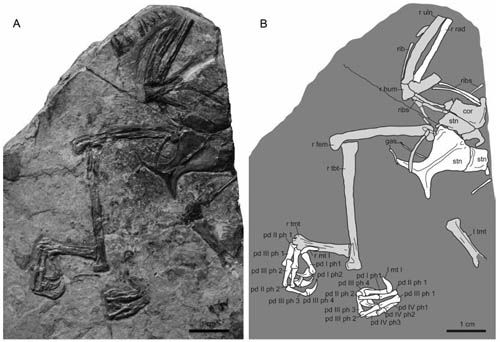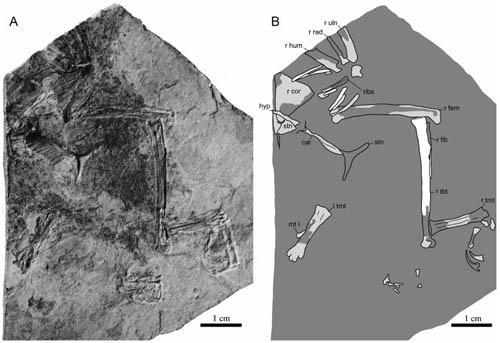New Study Indicates Mesozoic Liaoningornis is an Enantiornithine Bird
The Jehol Group of northeastern China continues to be the world’s richest source of knowledge on Mesozoic birds. Multiple lineages of birds are recognized, ranging from primitive long-tailed birds to the close-relatives of modern birds, the earliest known members of the clade Ornithurae (Ornithuromorpha). However, many of the earliest discovered ornithurine birds are highly fragmentary. Dr. Jingmai O’Connor, post-doctoral researcher at the Institute of Vertebrate Paleontology and Paleoanthropology (IVPP), Chinese Academy of Sciences, re-examined the only known specimen of Liaoningornis longidigitrus, first described by Hou in 1997, and found the taxon is in fact a member of Enantiornithes, as reported in the latest issue of Vertebrata PalAsiatic 2012(1).
The possible reassignment of Liaoningornis longidigitrus to Enantiornithes strongly affects existing hypotheses regarding avian evolution that have incorporated this taxon. For a long time, Liaoningornis was considered the oldest and earliest phylogenetic divergence within ornithurine birds. This widely accepted inference regarding the phylogenetic position of this taxon has been used to suggest that basal ornithurines were small and arboreal, an ecology retained ancestrally from closely related non-avian dinosaurs. This also implies that the cursoriality of ornithurines and their large size are derived features, and provides support for the arboreal hypothesis on the origin of flight. However, the reassignment of this taxon to Enantiornithes would mean that the fossil record no longer supports these hypotheses.
The only known specimen of Liaoningornis longidigitrus (IVPP V 11303) is a small individual in a slab and counterslab preserving a partial skeleton of recrystallized bone in ventral view. The specimen preserves only the distal part of the right coracoid, the sternum, a partial right wing, the complete left hindlimb, and the right foot. Some feather impressions are preserved in the counterslab near to the right tibiotarsus. The bones are not well-preserved; most elements are either largely abraded (partial wing), broken (tibiotarsus), or split between the two slabs (coracoid).
Although based on fragmentary and poorly preserved material, the absence of a well-developed sternum, lack of developed cnemial crests on the tibiotarsi and reduced pedal unguals suggests Liaoningornis should be excluded from the more advanced ornithothoracine clade. The taxon remains distinct from all known enantiornithines, although it shows similarity to the Spanish taxon Eoalulavis hoyasi; shared features of the sternum suggest a close relationship between these two, although disparity from other enantiornithines suggests this may be an artifact of ontogeny. The Liaoningornis specimen is too fragmentary to be able to make strong inferences about its placement within the diverse enantiornithine clade.
“Although there are no characters that allow us to definitively assign Liaoningornis to Enantiornithes, the preserved combination of features strongly suggests such a relationship, while clear diagnostic features of ornithurines are entirely lacking from the specimen”, said Dr. O’Connor, “Given the absence of any true enantiornithine synapomorphies preserved in IVPP V 11303, it would be most parsimonious to await new material to support this reassignment. Liaoningornis is thus reassigned to Enantiornithes with the recommendation that researchers use this taxon with caution, especially when forming evolutionary hypotheses that may rely on it.”
This study was supported by the Chinese National Natural Science Foundation.

Fig.1 Photograph (A) and camera lucida drawing (B) of the main slab of IVPP V 11303 (Image by Jingmai O’Connor)

Fig.2 Photograph (A) and camera lucida drawing (B) of the counterslab of IVPP V 11303 (Image by Jingmai O’Connor)
Download attachments: